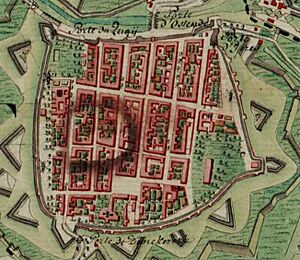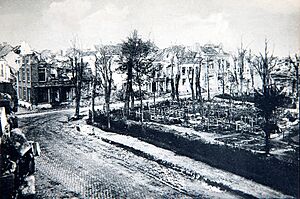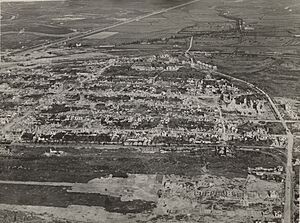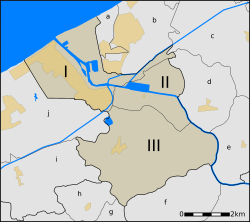Nieuwpoort, Belgium facts for kids
Quick facts for kids
Nieuwpoort
Nieuwpôort (West Flemish)
Nieuport (French)
|
|||
|---|---|---|---|

Belfry and city hall
|
|||
|
|||
| Country | Belgium | ||
| Community | Flemish Community | ||
| Region | Flemish Region | ||
| Province | West Flanders | ||
| Arrondissement | Veurne | ||
| Area | |||
| • Total | 31.00 km2 (11.97 sq mi) | ||
| Population
(2018-01-01)Lua error in Module:Wd at line 1575: attempt to index field 'wikibase' (a nil value).
|
|||
| • Total | Lua error in Module:Wd at line 1,575: attempt to index field 'wikibase' (a nil value). | ||
| Postal codes |
8620
|
||
| Area codes | 058 | ||
| Website | www.nieuwpoort.be | ||
Nieuwpoort is a city and a municipality in Flanders, one of the three main regions of Belgium. It is located in the province of West Flanders.
The municipality includes the main town of Nieuwpoort, plus two smaller villages: Ramskapelle and Sint-Joris. In 2008, Nieuwpoort had about 11,062 people living there. The land area is 31 square kilometers, meaning about 350 people live in each square kilometer. The current mayor is Geert Vanden Broucke.
In Nieuwpoort, the Yser river flows into the North Sea. The city is also home to a famous statue called Searching for Utopia by artist Jan Fabre. The old market hall, called the Stadshalle Grain Hall, has a special bell tower known as a belfry. This belfry was added to the UNESCO World Heritage List in 1999. It's important because of its history and unique design.
History of Nieuwpoort
Nieuwpoort became a city in 1163. This special right was given by Count Philip of Flanders. A big battle, called the Battle of Nieuwpoort, happened here in 1600 between the Dutch and the Spanish.
For a while, Nieuwpoort was a base for the Dunkirkers, who were privateers (like legal pirates). In the 17th century, painter Victor Boucquet created two altarpieces for the city's main church. From 1757 to 1763, French forces took control of the city.
In the 1800s, a large water system called the Ganzepoot (which means goose foot in Dutch) was built in Nieuwpoort. This system helped drain the polders (low-lying land protected by dikes) and control water flow to the North Sea.
During World War I, Nieuwpoort played a very important role. In 1914, during the Battle of the Yser, a brave man named Hendrik Geeraert opened the sluice gates. These gates control the water from the Yser river. By opening them, he flooded the low lands, which stopped the German army from advancing.
Today, two monuments from World War I are near the Ganzepoot: the Nieuport Memorial and the King Albert I Memorial.
Towns within Nieuwpoort
The old city center of Nieuwpoort is about three kilometers away from the coast. Closer to the sea, a new area has grown, which is popular with tourists. These two parts are now connected by buildings along Albert I Laan street and the fishing port.
Besides Nieuwpoort itself, two small villages are part of the municipality. These villages are located in the flat, low-lying polder areas of Flanders. They are Sint-Joris and Ramskapelle.
| # | Name | Area | Population 1999 |
|---|---|---|---|
| I | Nieuwpoort | 10,18 | 9.437 |
| II | Sint-Joris | 5,54 | 259 |
| III | Ramskapelle | 15,28 | 555 |
Nieuwpoort is right on the sea. Along the coast, it shares borders with the municipalities of Koksijde (specifically its town Oostduinkerke) and Middelkerke (specifically its town Lombardsijde). Because the village of Ramskapelle stretches far inland, Nieuwpoort has many neighboring towns. Most of these towns belong to two larger municipalities:
|
Nieuwpoort in Books
A part of the story in Cecelia Holland's historical novel The Sea Beggars takes place in Nieuwpoort. This book is about the early days of the Eighty Years' War. In the story, the sailors feel unfairly treated by the Spanish rulers and decide to join the rebellious Watergeuzen.
Images for kids
See also
 In Spanish: Nieuwpoort para niños
In Spanish: Nieuwpoort para niños













